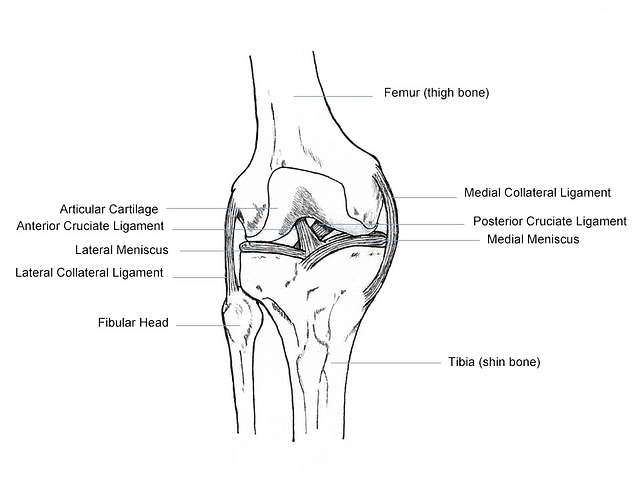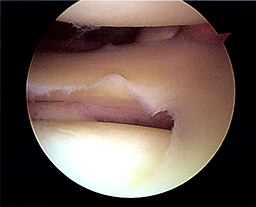Common Injuries Associated With ACL Tears

An anterior cruciate ligament (ACL) tear is one of the most serious knee injuries, often occurring in high-demand sports or due to trauma. However, ACL injuries rarely happen in isolation. Due to the mechanics of how the injury typically occurs, (rapid deceleration, twisting, or blunt force), there is often associated damage to other structures of the knee.
Understanding the range of injuries that may accompany an ACL tear is critical for accurate diagnosis, treatment planning, and long-term joint health. After an injury when you see healthcare professionals they should be considering some of these concomitant injuries. It’s possible that recognition of such things is better done by orthopedic or sports injury specialists.
Meniscal Tears

CC BY-SA 3.0 via Wikimedia Commons
The menisci are two crescent-shaped pads of fibrocartilage (medial and lateral) located between the femur (thighbone) and tibia (shinbone). They act as shock absorbers and stabilize the knee joint.
Meniscal tears are extremely common in conjunction with ACL injuries. In fact, over half of ACL injuries involve meniscal damage; especially the medial meniscus, due to its relative immobility. Tears can be partial or complete, with symptoms including joint locking, clicking, or instability. In young athletes, traumatic twisting is the usual cause. In older adults, degeneration may result in tears from minimal trauma.
Posterior Cruciate Ligament (PCL) Injuries
The PCL lies just behind the ACL and serves to prevent the tibia from sliding too far backward under the femur. While PCL injuries are less common than ACL injuries, they can occur in tandem, especially in high-energy trauma like car accidents or contact sports.
Isolated PCL injuries are usually caused by a direct impact to the tibia when the knee is flexed (e.g., dashboard injury). Combined ACL/PCL tears can lead to significant knee instability and typically require surgical intervention.
Medial and Lateral Collateral Ligament Injuries (MCL & LCL)
The collateral ligaments stabilize the inner (medial) and outer (lateral) sides of the knee. The MCL is more commonly injured, particularly in ACL injuries that result from valgus force (inward bending of the knee).
MCL injuries are frequently seen in contact sports and may occur alongside ACL tears. LCL injuries are less common but more often associated with multi-ligamentous knee injuries.
Articular Cartilage Damage
The articular cartilage covers the ends of the bones within the knee joint and enables smooth motion. Trauma severe enough to tear the ACL often results in osteochondral lesions—injuries to both the cartilage and the underlying bone.
Left untreated, these can accelerate the development of osteoarthritis and result in long-term joint degeneration.
Bone Contusions (Bone Bruises)
MRI imaging often reveals bone bruising following an ACL rupture. These are microfractures in the trabecular (spongy) bone, typically seen in the lateral femoral condyle and posterolateral tibial plateau due to the pivot-shift mechanism of injury.
Though not always symptomatic, bone bruises can contribute to pain and swelling and indicate the severity of trauma sustained by the joint.
Patellar Dislocation
The patella (kneecap) can be dislocated during high-impact injuries, especially in younger athletes. Patellar dislocations can damage the medial patellofemoral ligament (MPFL) and often accompany ACL tears due to rotational forces across the knee.
Subluxation or full dislocation of the patella may require reduction, bracing, and sometimes surgery.
Hamstring and Quadriceps Injuries
The hamstring muscles play a role in dynamic knee stabilization. A forceful injury that ruptures the ACL can also strain or tear these muscles, particularly the semimembranosus, which contributes to medial knee support. Conversely, the quadriceps tendon may be injured in forceful extension or during compensatory movement after an ACL tear.
These muscular injuries are important to address in rehabilitation planning.
Iliotibial Band Syndrome (ITBS)
Though not an acute injury from trauma, ITBS can be aggravated during recovery from an ACL tear—especially if biomechanics are altered. This overuse injury causes lateral knee pain and is common in runners and cyclists.
Osteoarthritis (OA)
Over time, ACL injuries—especially those with meniscal and cartilage damage—substantially increase the risk of post-traumatic osteoarthritis. The altered biomechanics, instability, and inflammatory environment within the joint can lead to cartilage degeneration and chronic pain.
Patellofemoral Pain Syndrome
Following ACL injury or reconstruction, poor tracking of the patella may result in patellofemoral pain syndrome (PFPS). This condition involves irritation of the cartilage behind the patella, often leading to pain during stair climbing, squatting, or prolonged sitting.
Summary
ACL injuries are complex and often part of a larger pattern of trauma to the knee joint. A thorough assessment, including MRI imaging and clinical examination, is essential to evaluate associated injuries. Comprehensive treatment—whether surgical or conservative—must address all damaged structures to restore function, reduce pain, and prevent long-term complications.
See Also
📰 Web Articles
- Knee Anatomy Overview
- Understanding Meniscal Tears
- Posterior Cruciate Ligament (PCL) Injuries
- Collateral Ligament Injuries
- Articular Cartilage Injuries
- Articular cartilage injuries are damage to the cartilage tissue on the surface of the joint
- Bone bruising in the knee – Causes, symptoms, and treatment
- Patellar Dislocation
- Patellofemoral Pain Syndrome